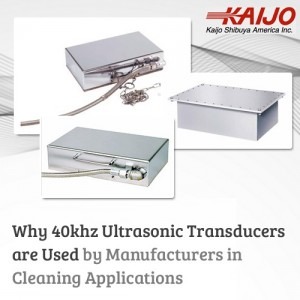Why 40kHz Ultrasonic Transducers Are Used by Manufacturers in Cleaning Applications
August 16, 2016
 Industrial manufacturing facility managers and business owners are finding that ultrasonic cleaning systems offer significant advantages over traditional chemical-based cleaning methods. Ultrasonic systems provide significant operational cost savings because they don’t require the use of chemicals and the costs of compliance with environmental regulations. Ultrasonic systems clean faster and more effectively and can clean the surface of oddly shaped devices or parts. The main question that remains before making a purchasing decision is regarding the frequency that will be best for the particular cleaning application.
Industrial manufacturing facility managers and business owners are finding that ultrasonic cleaning systems offer significant advantages over traditional chemical-based cleaning methods. Ultrasonic systems provide significant operational cost savings because they don’t require the use of chemicals and the costs of compliance with environmental regulations. Ultrasonic systems clean faster and more effectively and can clean the surface of oddly shaped devices or parts. The main question that remains before making a purchasing decision is regarding the frequency that will be best for the particular cleaning application.
Ultrasonic cleaning systems operate at frequencies between about 20 kHz and 200 kHz. The cleaning system includes a generator, transducer and a cleaning tank. The transducer creates ultrasonic waves that produce bubbles in the water of the cleaning tank. Low frequencies generate larger bubbles and more intensive cleaning while the small bubbles of high frequencies will clean more gently. A 40 kHz ultrasonic transducer generates mid-range to large bubbles that clean a wide range of manufactured parts well but are not as aggressive as the large bubbles generated at the 20 kHz range.
Ultrasonic Cleaning System Components
In an ultrasonic cleaning system, a generator produces the high-frequency electric signal and the transducer converts the signal to sound waves in water. One or more transducers are located inside the tank that holds the cleaning solution and the parts to be cleaned. Transducers can be designed to handle different frequencies but they have to match the frequencies produced by the ultrasonic generator. The tanks are the same no matter what frequency is used.
For a 40 kHz generator, corresponding 40 kHz ultrasonic transducers can be immersible, bolt-on or tank mounted. Immersible transducers are supplied as separate units with an electrical cable connection and can be moved and placed anywhere in the cleaning tank. Bolt-on transducers are bolted onto the bottom or sides of a tank while mounted transducers are already installed.
Turnkey systems may come with a tank that has the transducers already mounted or has bolt-on transducers that can be changed for different frequencies. For customers purchasing just the transducers or wanting to retrofit an existing tank, the immersible or bolt-on transducers may be more appropriate because they offer more installation flexibility.
Parts to be Cleaned
The parts or components to be cleaned and the nature of contamination or dirt determine which frequency is the most appropriate for ultrasonic cleaning. Heavy deposits to be removed from robust parts require a low frequency with intensive cleaning. Delicate parts with only a dirty film or microscopic particles require high frequencies. The mid-range frequency of 40 kHz combines the most desirable features of both extremes.
For example, at 40 kHz, a cleaning system can effectively clean machined parts, industrial devices, ceramics, jewelry, electronics such as hard disk drive parts, wires and glass parts such as lenses. Both heavy contamination and light films are removed effectively without damaging the surface of the parts to be cleaned.
Kaijo can supply 40 kHz nominal (38 kHz actual) transducers in immersible, bolt-on and tank-mounted configurations. The transducers are available in 600 W and 1200 W models and can withstand cleaning solution temperatures of up to 100 degrees Celsius. Kaijo has the ultrasonic cleaning technology and experience to help customers choose the transducers or ultrasonic cleaning solutions most appropriate for their applications. For a free consultation or quote on selecting the right ultrasonic cleaning system and transducer for your specific cleaning application call Kaijo at 408 675-5575 or email info@kaijo-shibuya.com.





